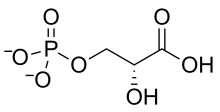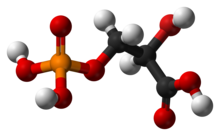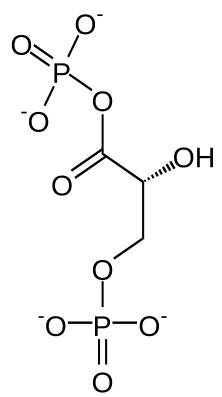From Wikipedia, the free encyclopedia
3-Phosphoglyceric acid
Names
IUPAC name
(2R )-2-Hydroxy-3-phosphonooxypropanoic acid
Identifiers
ChEBI
ChEMBL
ChemSpider
InChI=1S/C3H7O7P/c4-2(3(5)6)1-10-11(7,8)9/h2,4H,1H2,(H,5,6)(H2,7,8,9)/t2-/m1/s1
Y Key: OSJPPGNTCRNQQC-UWTATZPHSA-N
Y
C([C@H](C(=O)O)O)OP(=O)(O)O
Properties
C 3 H 7 O 7 P
Molar mass
186.06 g/mol
Except where otherwise noted, data are given for materials in their
standard state (at 25 °C [77 °F], 100 kPa).
Chemical compound
3-Phosphoglyceric acid (3PG ), or glycerate 3-phosphate (GP )[citation needed , is a biochemically significant 3-carbon molecule that is a metabolic intermediate in both glycolysis and the Calvin cycle . This chemical is often termed PGA when referring to the Calvin cycle. In the Calvin cycle, 3-Phosphoglycerate is the product of the spontaneous split of an unstable 6-carbon intermediate formed by CO2 fixation. Thus, two 3-phosphoglycerate molecules are produced for each molecule of CO2 fixed.
Glycolysis
Compound C00236 at KEGG Pathway Database. Enzyme 2.7.2.3 at KEGG Pathway Database. Compound C00197 at KEGG Pathway Database. Enzyme 5.4.2.1 at KEGG Pathway Database. Compound C00631 at KEGG Pathway Database.
Click on genes, proteins and metabolites below to link to respective articles. [§ 1]
[[File:
|alt=Glycolysis and Gluconeogenesis
edit ]]
Glycolysis and Gluconeogenesis
edit
Calvin cycle
In the light-independent reactions (also known as the Calvin cycle), two 3-phosphoglycerate molecules are synthesized, one of which continues through the Calvin cycle to be regenerated to RuBP and the other is reduced to form one molecule of glyceraldehyde 3-phosphate (G3P). This is the first compound formed during the C3 or Calvin cycle. It is a reactive biomolecule that is easily reduced.
Amino acid synthesis
Glycerate 3-phosphate is also a precursor for serine , which, in turn, can create cysteine and glycine through the homocysteine cycle.
See also
Notes
Receptor (ligands )
GlyR Tooltip Glycine receptor
Positive modulators: Alcohols (e.g., brometone , chlorobutanol (chloretone) , ethanol (alcohol) , tert -butanol (2M2P)tribromoethanol , trichloroethanol , trifluoroethanol )Alkylbenzene sulfonate Anandamide Barbiturates (e.g., pentobarbital , sodium thiopental )Chlormethiazole D12-116 Dihydropyridines (e.g., nicardipine )Etomidate Ginseng constituents (e.g., ginsenosides (e.g., ginsenoside-Rf ))Glutamic acid (glutamate) Ivermectin Ketamine Neuroactive steroids (e.g., alfaxolone , pregnenolone (eltanolone) , pregnenolone acetate , minaxolone , ORG-20599 )Nitrous oxide Penicillin G Propofol Tamoxifen Tetrahydrocannabinol Triclofos Tropeines (e.g., atropine , bemesetron , cocaine , LY-278584 , tropisetron , zatosetron )Volatiles /gases (e.g., chloral hydrate , chloroform , desflurane , diethyl ether (ether) , enflurane , halothane , isoflurane , methoxyflurane , sevoflurane , toluene , trichloroethane (methyl chloroform) , trichloroethylene )Xenon Zinc Antagonists: 2-Aminostrychnine 2-Nitrostrychnine 4-Phenyl-4-formyl-N-methylpiperidine αEMBTL Bicuculline Brucine Cacotheline Caffeine Colchicine Colubrine Cyanotriphenylborate Dendrobine Diaboline Endocannabinoids (e.g., 2-AG , anandamide (AEA) )Gaboxadol (THIP) Gelsemine iso-THAZ Isobutyric acid Isonipecotic acid Isostrychnine Laudanosine N-Methylbicuculline N-Methylstrychnine N,N-Dimethylmuscimol Nipecotic acid Pitrazepin Pseudostrychnine Quinolines (e.g., 4-hydroxyquinoline , 4-hydroxyquinoline-3-carboxylic acid , 5,7-CIQA , 7-CIQ , 7-TFQ , 7-TFQA )RU-5135 Sinomenine Strychnine Thiocolchicoside Tutin Negative modulators: Amiloride Benzodiazepines (e.g., bromazepam , clonazepam , diazepam , flunitrazepam , flurazepam )Corymine Cyanotriphenylborate Daidzein Dihydropyridines (e.g., nicardipine , nifedipine , nitrendipine )Furosemide Genistein Ginkgo constituents (e.g., bilobalide , ginkgolides (e.g., ginkgolide A , ginkgolide B , ginkgolide C , ginkgolide J , ginkgolide M ))Imipramine NBQX Neuroactive steroids (e.g., 3α-androsterone sulfate , 3β-androsterone sulfate , deoxycorticosterone , DHEA sulfate , pregnenolone sulfate , progesterone )Opioids (e.g., codeine , dextromethorphan , dextrorphan , levomethadone , levorphanol , morphine , oripavine , pethidine , thebaine )Picrotoxin (i.e., picrotin and picrotoxinin )PMBA Riluzole Tropeines (e.g., bemesetron , LY-278584 , tropisetron , zatosetron )Verapamil Zinc NMDAR Tooltip N-Methyl-D-aspartate receptor
Transporter (blockers )
GlyT1 Tooltip Glycine transporter 1 GlyT2 Tooltip Glycine transporter 2
















